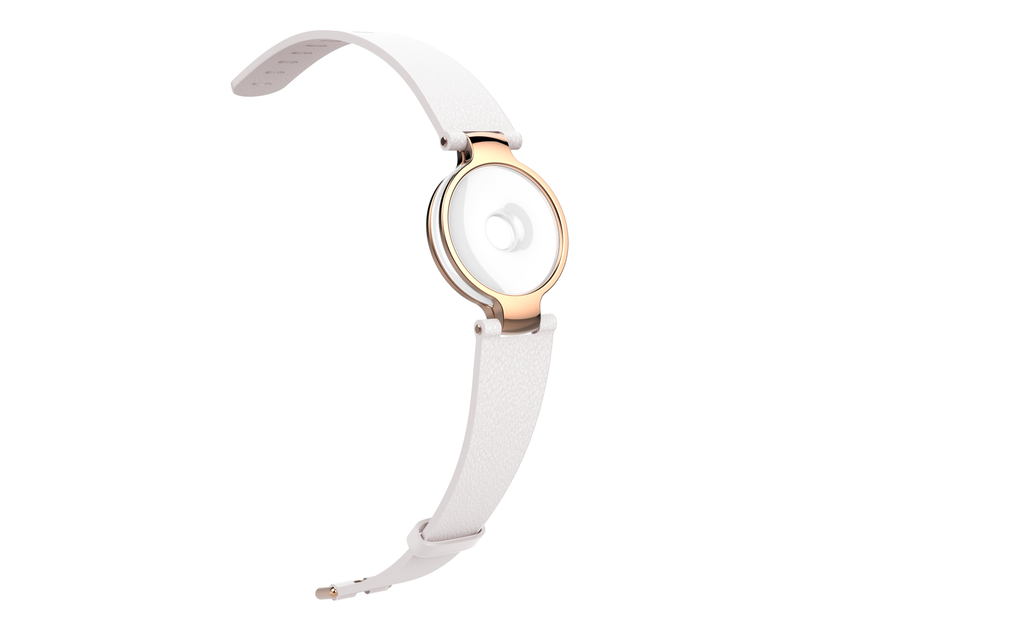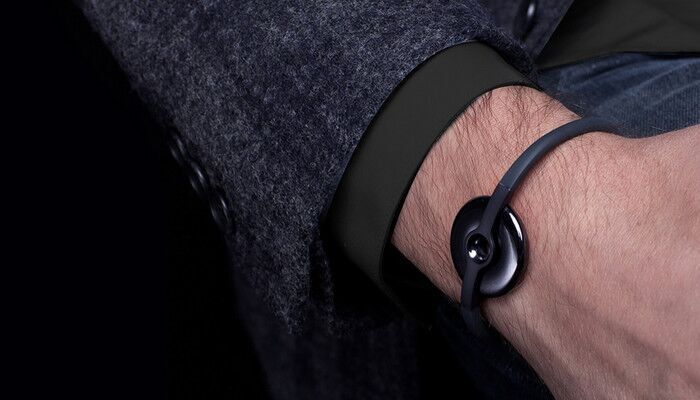I’m probably the last person in the fitness world not to try linking a fitness tracker to my smartphone. But for somebody like me who spends so much time looking at screens, I usually like to escape my phone while exercising.
Still, the modern times have caught up with me. I was recently traveling with somebody who constantly talked about his fitness tracker, and I felt just a twinge of fitness tracker envy. So when Amazfit offered to send me a sample to try, I said well… yes, please.

This model is called the Moonbeam.
Amazfit is trying to appeal to exercisers who want to look good, especially women, and don’t want some bulky thing with digital numbers on their arm. The Amazfit tracker is modeled after a jade disc, if you picture a black or white jade disc attached to a plastic strap. You can also choose to wear the disc as a pendant. I got the model called the Equator, which has a very thin strap. It looks more like a bracelet than a tracker, and the disc resembles hematite. The Chinese company Huami designed and manufactured this tracker. It’s pretty bare-bones –tracking steps, active calories and sleep — and you only see the readout when looking at your phone.
The first thing I noticed about my Amazfit was the elegant packaging. It comes in a complicated black box covered in shiny black on black paper. The accompanying instructions were minimal. But I recognized a charger, and saw that the disc fit into it, so that was pretty easy. I plugged it in until the light stopped flashing, and then it was ready to track.
I managed to sync the tracker with my phone and enter my gender, height and weight. My first frustration came with a prolonged updating of firmware, followed by trouble syncing, then more updating, then more attempts to sync, until the battery wore down and I had to charge it all over again. I tried signing out, signing back in, and reentering my information.
This time, it worked! I could now track my steps for the day, my active calories burned and my sleep duration and quality.
It took me a couple of days to figure out how to tighten the wrist strap. This is important because if it’s not tight enough, it doesn’t correctly track your calories. Even if it is tight enough, it’s calorie tracker is unreliable. The first two days I wore it, while the strap was loose, it seemed to think I burned about 40 calories no matter what I did. An hour of boot camp class? Forty calories. Climbing up and down 175 steps for 30 minutes? Yeah, that’s about 40 calories. Twenty minutes of high intensity intervals on an elliptical machine? We’ll call that 40 calories, too. That was a little discouraging. When I tightened the strap, it seemed to calculate accurately for a day. But the next day, it went back to its 40-calorie trick. Even when the elliptical told me I’d burned 100 calories, Amazfit still said forty. One week, I took an easy jog/walk of two miles on a Monday and backpacked 11 miles carrying a 30-pound pack on Wednesday, and ended up with an alleged 410 calories for each day. Hmm. Unreliable.

Guys can wear it, too.
Just like Santa Claus, the Amazfit knows when you’re sleeping and when you’re awake. How? I have no idea. But it seemed semi-accurate. If I go to bed at 1:45 a.m. and get up at 8:00, I can calculate that’s about six hours of bed time even without this device. But it divides sleep into deep and light and tells you how many times you wake up during the night, which is sort of interesting. Except that sometimes I woke up multiple times — and even got up to go to the bathroom twice — and Amazfit claimed I’d only woken up once.
The Amazfit stays on my wrist pretty well. But I did manage to dislodge the disc while setting up a step for boot camp class. I wouldn’t recommend wearing this tracker rock climbing, or for other activities where the disc could easily pop off.
In only four days, the Amazfit has already turned me into one of those people obsessed with taking at least 10,000 steps per day. Which isn’t always easy when you work at home. Now I log 200 steps while brushing my teeth and 300 while waiting for the microwave to chime. All this pacing around my house is freaking the dog out. I fear there’s no going back. But I might trade it in for a tracker that can more accurately measure calories burned.



